Performance and Testing Methodology
Finally, we come down to the performance data. However, I must preface this by saying the Ryzen 9 3900X was the only Ryzen 3000 series CPU I had time to evaluate prior to the embargo date. For general performance testing, we used virtually the same software we use in our motherboard testing and evaluation. However, I have added a couple of additional benchmarks into the mix. I had planned to add some additional games into the lineup but, ran out of time for that. Gaming performance is something we’ll follow up on and we will also review additional processors in the 3rd generation Ryzen family. So, keep that in mind. We are far from done on this topic. This information is concerning the Ryzen 9 3900X only.
Due to the schedular improvements to Windows 10 build 1903, we decided to use build 1903 for all system testing. While many of the applications here have been used before in our motherboard reviews, even with the same configurations, the numbers are not comparable. Those were all done on builds 1803 and 1809 using the drivers that were current then. All systems were freshly formatted and all the latest drivers and OS patches were used. All of the systems were updated to their latest BIOS revisions. Finally, for the Intel system, I did install the CPU microcode updates relevant to that CPU. Its important to note that build 1903 does contain improved mitigations for several security flaws on Intel processors. However, I did not go out of my way to download any additional or optional mitigation patches. Hyperthreading also remained enabled for all testing.
We also followed AMD’s recommendations for using CPPC2 which is enabled by using AMD’s balanced power plan. Essentially, we created a “best case” scenario for each system outside of the hardware configurations. For the hardware, it was impossible to use the same memory modules on all of the test systems due to the nature of memory compatibility on different motherboards. That said, we were able to use common frequencies and keep the timings relatively close for the most part. This was not the case with the Threadripper system, which would not cooperate regarding running tighter timings. It simply could not complete all the tests at the same timings used by other systems. The timings in the table are the RAM’s default timings at maximum speeds. They were all run at 16,18,18,36,1T @ DDR4 3200MHz.
Finally, all systems were run at stock and overclocked values. The “stock” settings are their automatic or default base/boost clocks. The boost clocks are shown in the graphs for reference. An overclocked value for each CPU was used as well, running all cores at a fixed speed. In the case of the Ryzen 9 3900X, an all core frequency of 4.3GHz was the highest we could achieve with full stability. This is the value that you will see. I am not convinced this is the best way to overclock a Ryzen 9 3900X, but I’ll talk more on that point later.

Application & Synthetic Testing
Sandra Memory Bandwidth
Note: All systems were run in dual channel mode, excluding our Threadripper system which used quad-channel mode. Again, all RAM was run at DDR4 3200MHz. The timings on all systems were 16,18,18,36,1T, excluding the Threadripper system which uses the default 18,19,19,39,1T values.
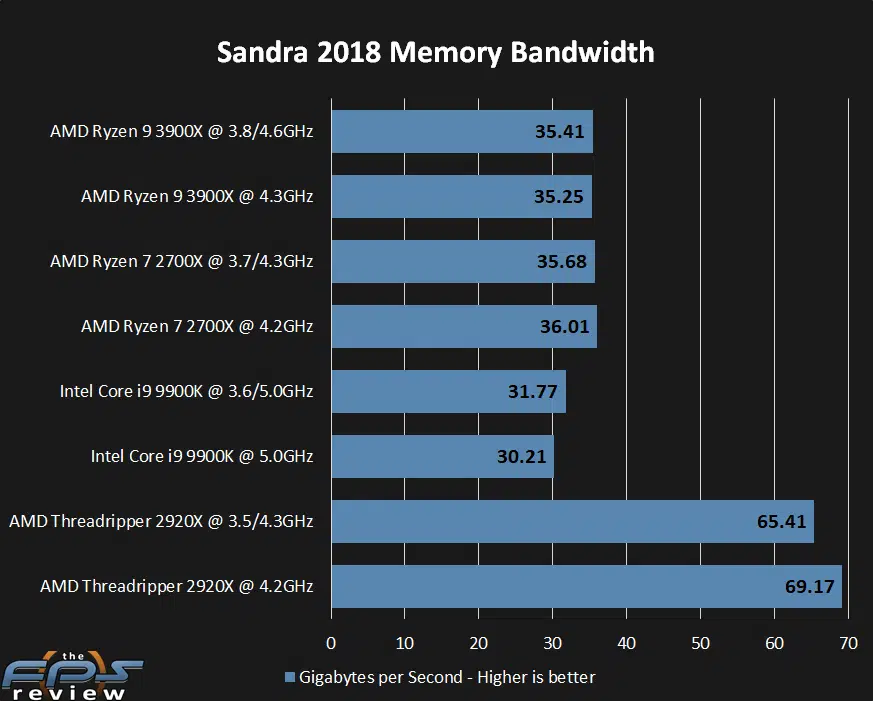
All of our Ryzen systems score essentially the same result. I was actually surprised that the Ryzen 9 3900X didn’t do better. However, it is capable of much greater speeds which is a topic for another day.
Sandra CPU Dhrystone
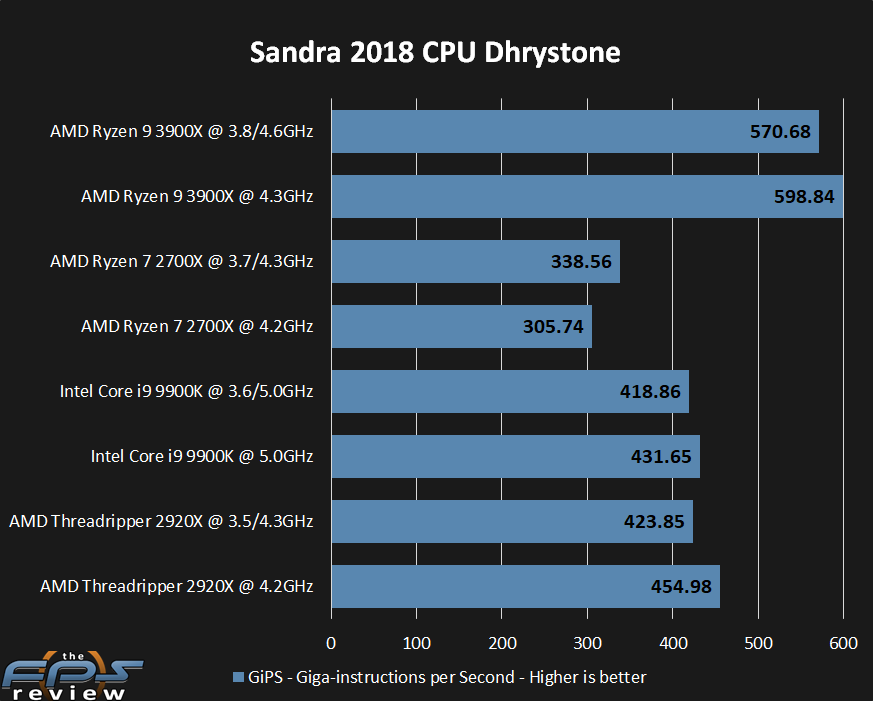
While the memory results weren’t anything special, its fair to say that the Ryzen 9 3900X is nothing short of a monster. The Ryzen 9 3900X is considerably faster than the Threadripper 2920X in this test. You would need a very expensive HEDT CPU to beat these numbers.
WinRAR – Multithread
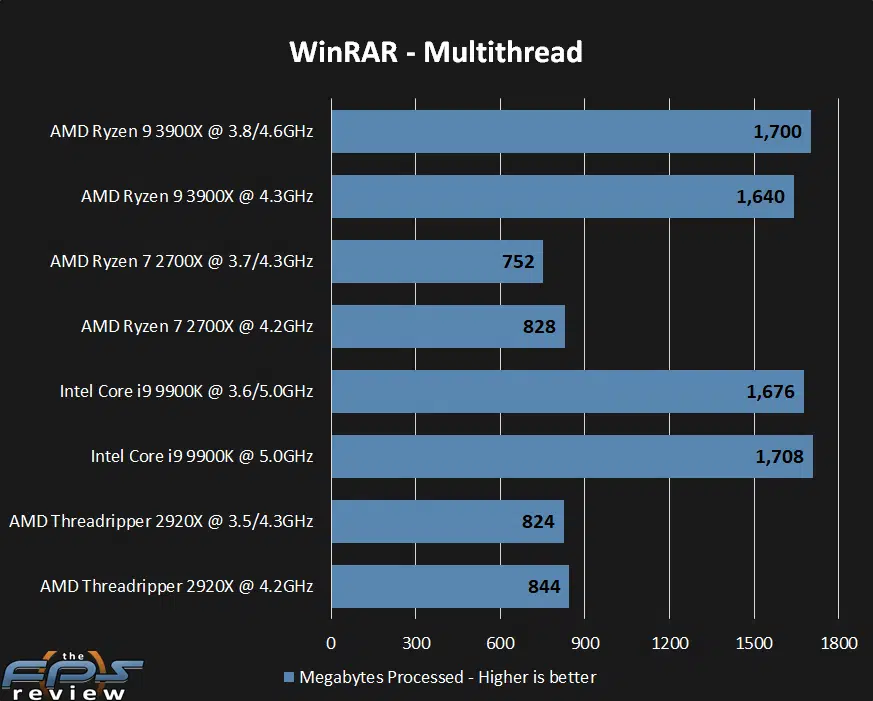
WinRAR is a weird test. While it does scale with additional threads, its still very much influenced by single-threaded performance. I don’t think it stretches that far into additional cores either. This is evidenced by the fact that the Core i9 9900K easily keeps up and slightly edges out the 3900X. It does show the strength of AMD’s
WinRAR – Single Thread
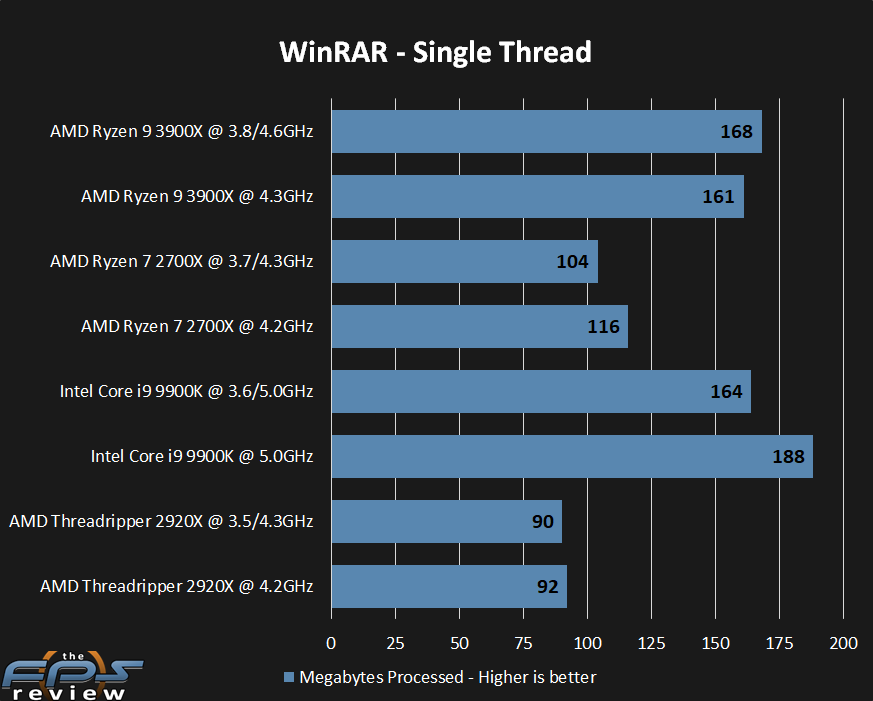
It’s not really a surprise that Intel’s Core i9 9900K is the king here. However, if you look at the results, once again we see near IPC parity between AMD’s 3rd generation Ryzen and Intel’s Coffee Lake architecture. The boost clocks of the Ryzen 9 3900K are relatively close to Intel’s Core i9 9900K. The latter actually loses to the Ryzen 9 3900X using their stock boost clocks. Its only overclocked to 5.0GHz that the Intel pulls ahead. One important note, while the Core i9 9900K can boost to 5.0GHz for single threaded applications, I almost never saw this actually happen. It ran at 4.8 or 4.9GHz most of the time.
wPrime v2.10

This this test we once again see very similar results between our Core i9 9900K and the Ryzen 9 3900X. At their normal boost clocks, AMD is actually faster here. The Intel Core i9 9900K gets close but, has to be overclocked to 5.0GHz on all cores to achieve this.
POV-Ray
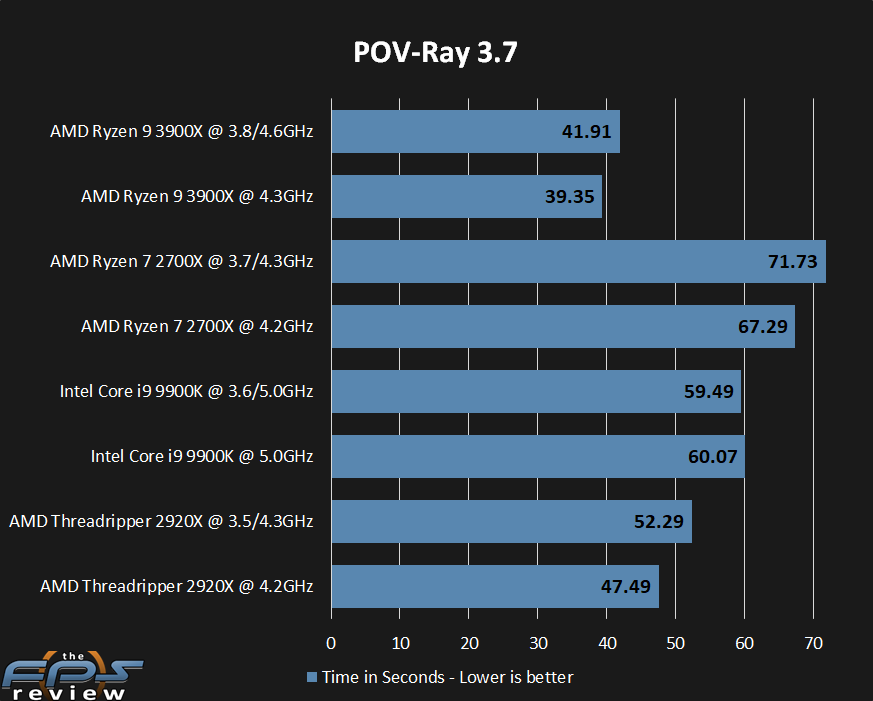
This is a test that clearly likes having access to more CPU cores. This is evidenced by the fact that the AMD Ryzen 9 3900X destroys all the other test systems save for the Threadripper 2920X which has the same core and thread count. Despite the memory bandwidth advantage of the Threadripper, it fails to match the 3rd generation Ryzen. This comes down to all the various architectural improvements and reduced latencies.
V-Ray
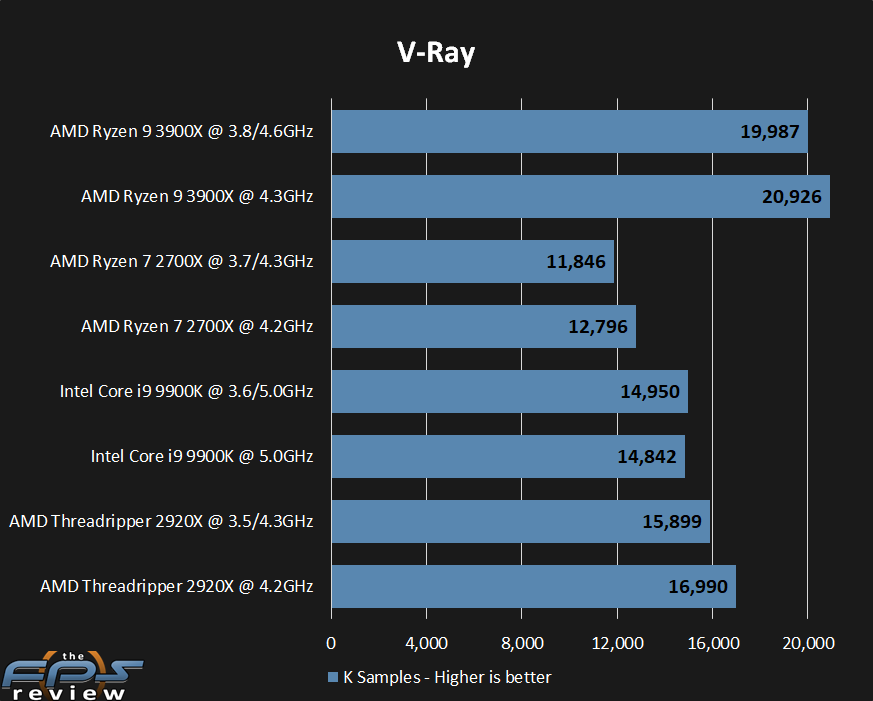
The graphs pretty much say it all. The Ryzen 9 3900X is an absolute monster here. You can see what the improvements in the third generation Ryzen CPU’s bring to the table by looking at the Threadripper 2920X results. The 100MHz advantage when all of the Ryzen 9 3900X’s cores are overclocked vs. the Threadripper probably has very little to do with the massive difference we see between those two platforms. Otherwise, we would see different deltas across the other CPU’s if clock speed mattered that much.
Cinebench R20 – Multithread

This can only be described as AMD’s favorite test. It appears in most of AMD’s slides where performance is compared to Intel’s CPU’s. According to Intel, Cinebench represents something of a best-case scenario for AMD. I’d say that’s true to an extent judging by the results in the single-threaded test. We know Cinebench loves CPU cores and it shows. AMD’s Ryzen 9 3900X has a four core and eight thread advantage and it has a huge impact on these results. Again, the only system remotely close to the Ryzen 9 3900X test platform is the Threadripper 2920X. Despite the core and thread counts being the same, the 3rd generation Ryzen is still considerably faster. This shows just how much of an improvement there is in AMD’s Zen 2 architecture.
Cinebench R20 – Single Thread
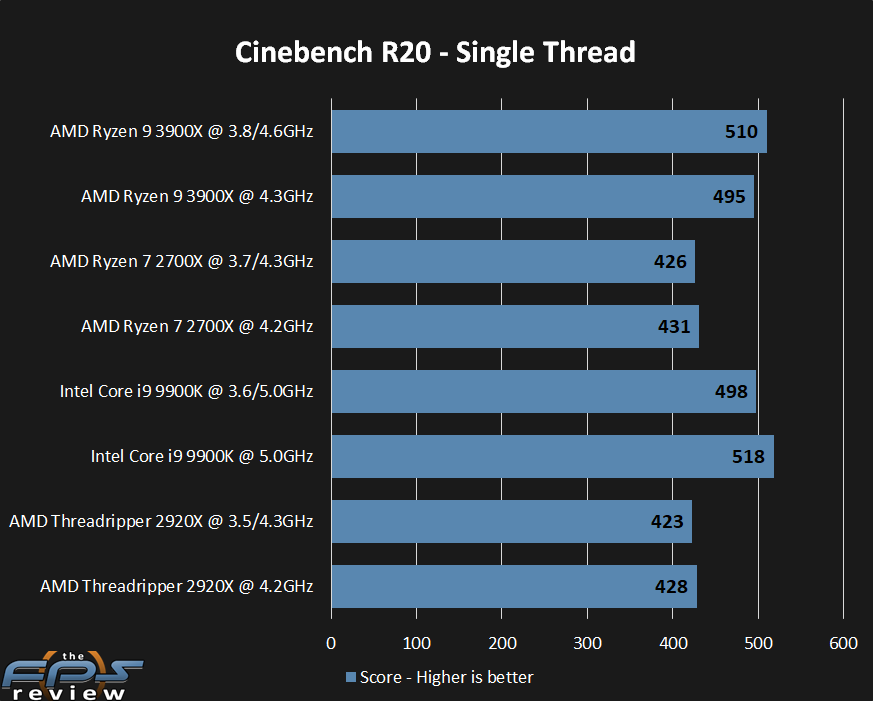
As I said, the single threaded results do indicate an advantage for AMD’s architecture here. It is a best-case scenario as AMD is only 8 points off Intel’s Core i9 9900K despite the latter having a clock speed advantage.
Adobe After Effects CC – Puget Systems Benchmark
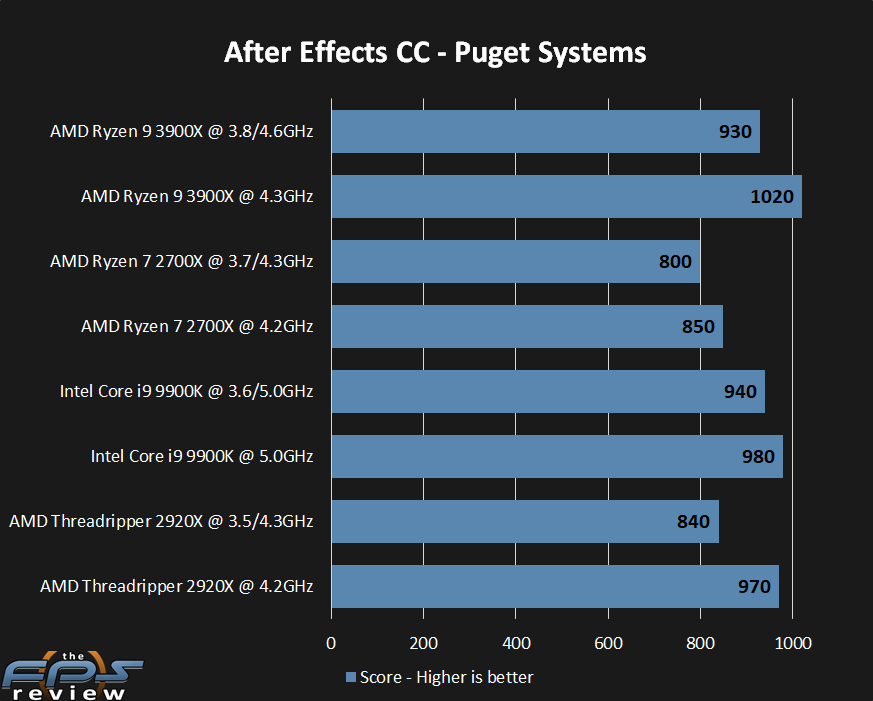
This is the first time we’ve used this test. This was suggested by one of our forum members, and I have to say, I’ve been rather impressed with it. However, it is worth pointing out that there is some GPU acceleration here as I’ve tried this with various GPU’s and it can radically alter the results. Adjustments to the CPU’s clock speeds and core counts also makes a substantial impact, which is why I left the test in the lineup. We used the same graphics cards for all of the comparisons, making the GPU a constant variable.
Blender
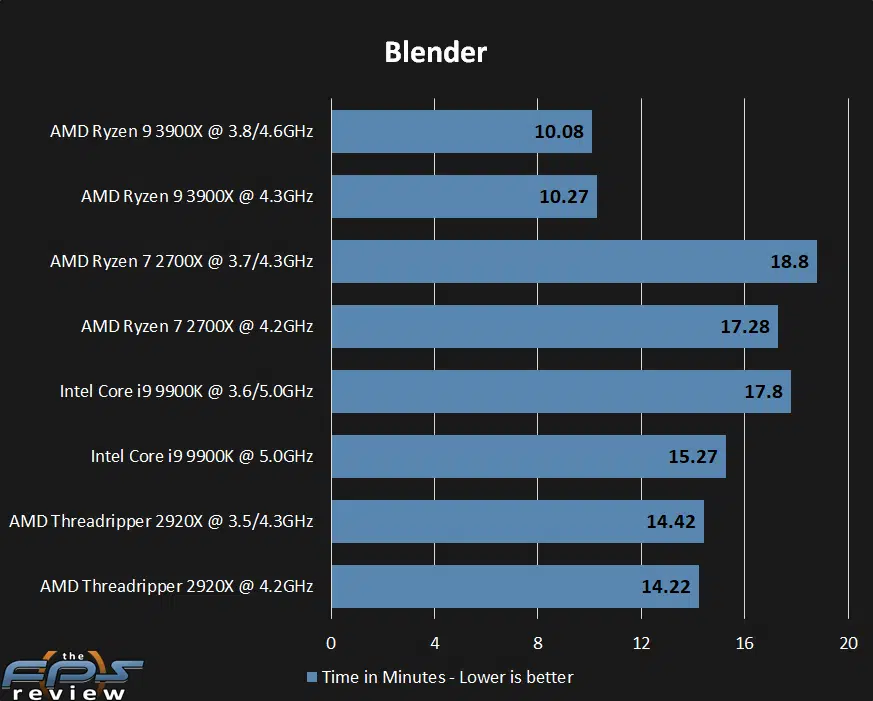
Blender is a mixed bag for me. On one hand, it’s a nice test but if there is a remote hint of instability, this test shows it. Essentially, if I could run Blender, that configuration would pass any test I threw at it. This is the test that actually highlighted how unstable our Ryzen 9 3900X was at 4.4GHz or beyond. That said, it’s a good multithreaded test which shows a massive improvement as cores are added, but it also highlights the difference between our Threadripper 2920X and the Ryzen 9 3900X. Again, the Ryzen 9 3900X has no equal here. It’s worth noting that the fastest result came from running all the cores at 4.3GHz.
Gooseberry
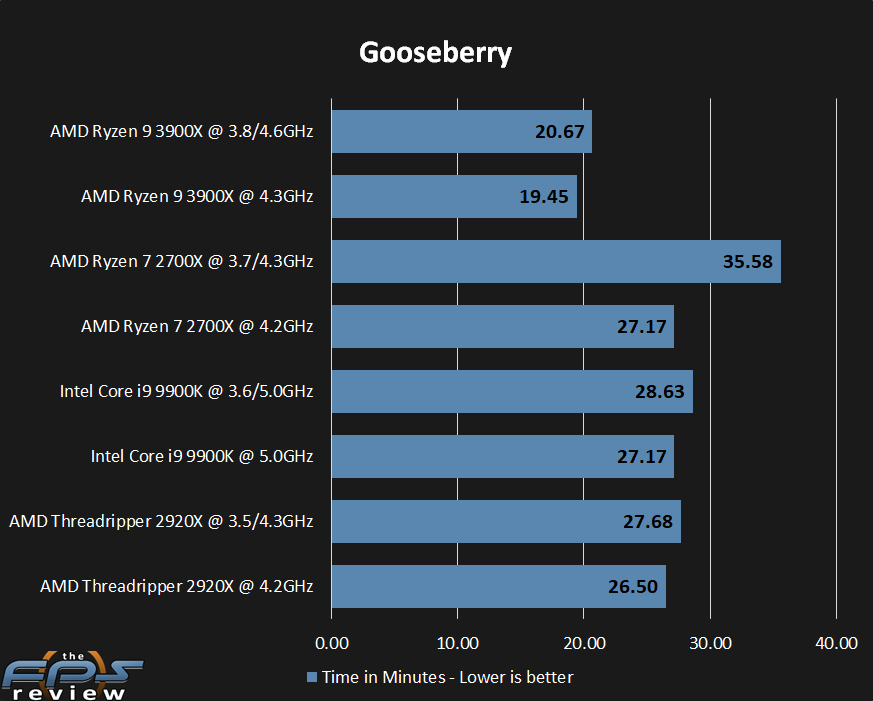
In this test we see more of AMD’s claims of content creation dominance in action. At default settings and via a manual overclock, the Ryzen 9 3900X simply crushes the competition.
